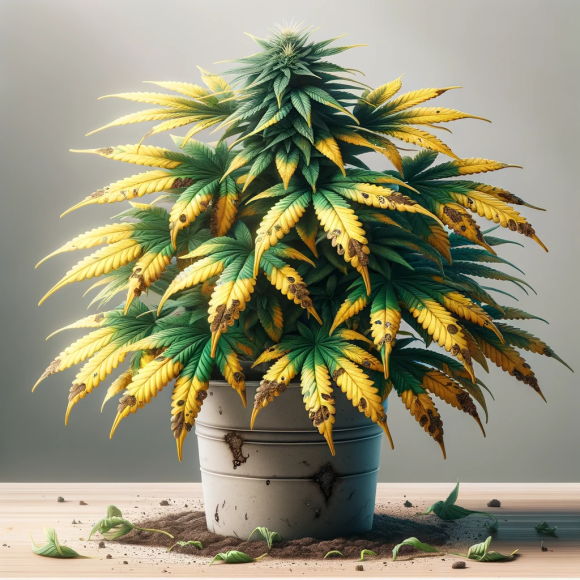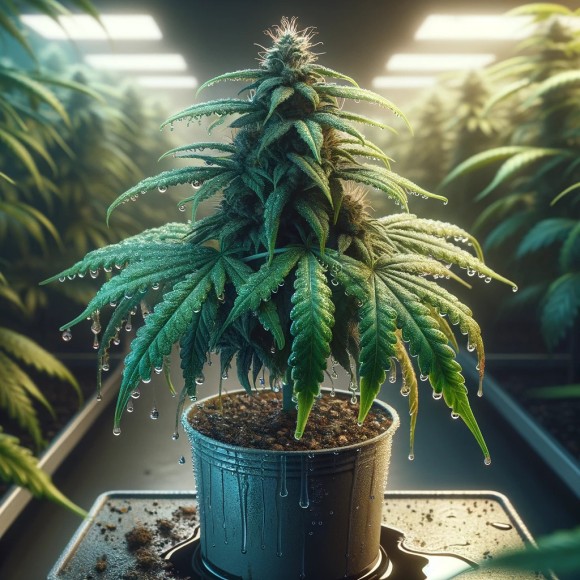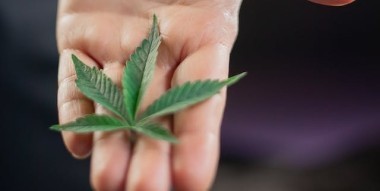If you've noticed your cannabis plants looking under the weather, you're not alone. Nutrient deficiencies can sneak up on even the most experienced growers, leading to yellow leaves and stunted growth.
In this article, we'll navigate through the signs of these deficiencies and provide practical solutions for a healthy harvest. Keep reading to turn over a new leaf in your cannabis cultivation journey!
Key Takeaways
- Check your cannabis plant's leaves for color changes, spots, or curling to find nutrient problems early.
- Use the right soil pH and balanced nutrients to keep plants healthy.
- Nitrogen, phosphorus, potassium, calcium, magnesium, zinc, iron, copper, boron, manganese, sulfur and silica are all important for cannabis growth.
- To fix deficiencies add specific supplements to the soil or as a foliar spray.
- Prevent problems by testing water quality and using organic matter in your soil.
Understanding Cannabis Deficiencies
Cannabis plants need certain nutrients to grow strong and healthy. Just like humans can get sick if they don't eat the right foods, cannabis plants suffer without proper nutrition.
Each nutrient plays a unique role. For example, nitrogen helps leaves stay green and full of life. Phosphorus is essential for solid roots and giant flowers. Potassium keeps the plant's systems working well.
Plants show signs when they lack nutrients, which are called deficiencies. Yellow or spotted leaves could mean there's not enough zinc around. Potassium might be too low if stems are weak or leaves look burnt at the edges.
Understanding these signs helps growers fix problems quickly. They can adjust what they feed their plants or change how much water they give them to ensure every nutrient is balanced for healthy growth.
Common Cannabis Nutrient Deficiencies & How to Correct Them
Navigating the health of your cannabis plants can sometimes feel like a complex puzzle, but don't fret—recognizing and rectifying common nutrient deficiencies is key to robust growth.
From yellowing leaves signaling a lack of nitrogen to weak stems crying out for more calcium, each symptom offers clues to bring your plants back to their peak condition. Let's delve into the essential nutrients cannabis requires and how you can correct imbalances before they compromise your crop.
ALSO READ: How To Dry Cannabis In Paper Bag: The Ultimate Guide
Nitrogen deficiency (N)
Yellow, wilting leaves at the bottom of your cannabis plant could mean it's lacking nitrogen. This essential nutrient makes the leaves green and helps them catch sunlight to make food for growth.
Without enough nitrogen, your marijuana plants can't grow strong and healthy.
Fixing a nitrogen deficiency is all about giving your plants the right food. You might add more compost or manure to the soil. Some growers even use special fertilizers that have extra nitrogen in them.
Just be careful not to overdo it – too much can be as harmful as not enough.
After solving issues with nitrogen, you may need to look for signs of other problems, like phosphorus deficiency (P), which we'll explore next.
Phosphorus deficiency (P)
After tackling nitrogen, let's shift focus to phosphorus deficiency in cannabis. Phosphorus is vital from the start of a plant's life until harvest time. If your cannabis plants lack this nutrient, you may notice some troubling signs.
Dark green or purple leaves can signal trouble, along with slow growth and weak stems. This issue often crops up during the flowering stage when plants are hungry for nutrients.
Fixing a phosphorus shortage involves several steps. Check the soil pH first—it should be just right to help roots take up phosphorus effectively. Next, ensure your soil isn't holding back, providing all the essential elements your plant craves.
Also, watch out for overwatering, which can compound the problem by preventing proper absorption of nutrients like phosphorus, which is critical for energy transfer and robust root development in cannabis plants.

Potassium deficiency (K)
Potassium deficiency in cannabis can make leaves look sick. They may turn white, yellow, brown, or even seem burnt. This nutrient helps the plant activate enzymes and stay strong. Without enough potassium, a plant might not handle water well or breathe properly through its leaves.
Watch for signs during the blooming stage when buds are forming.
Leaf tips often give away a potassium problem first. They might curl upward while turning yellow or brown at the edges. Spotting these clues early helps fix potassium levels before it's too late.
Keeping this macronutrient balanced is vital to healthy growth and bountiful harvests.
ALSO READ: Kush Mint Strain Exposed: Unveiling its Rare and Unique Attributes
Calcium (Ca) & Magnesium (Mg) deficiency
Calcium and magnesium are key nutrients for healthy cannabis plants. These minerals help with strong root development and overall plant vigor. If your plants don't get enough, they might show slow growth and weak buds.
Calcium can't reach the roots well if the soil is too acidic or cold. Magnesium may also struggle in these conditions or if potassium levels are high. Leaves may turn yellow between the veins when these nutrients are lacking.
To fix a shortage of calcium or magnesium, you can add dolomite lime for lasting improvement. For quick results, foliar sprays with calcium-magnesium solutions work well. Just mix them according to instructions and spray on the leaves.
Using worm castings or composted materials can prevent problems before they start. They release nutrients slowly into the soil so plants stay fed over time. It's all about balance – not too much, not just a little, but just right for thriving cannabis plants.
Zinc deficiency (Zn)
Zinc plays a crucial role in helping cannabis plants grow strong and healthy. Without enough zinc, your plants might grow stunted or have trouble developing good flowers. Leaves can become thin, stretch out, and look yellow between the veins.
High pH levels or soggy roots often cause zinc to be less available to plants. Check the root system if you think there's a deficiency. You may need to adjust your watering habits and confirm that the soil isn't too alkaline.
To fix a lack of zinc, add micro-elements tailored for cannabis directly into the feeding schedule.
Keep an eye on your plant after adding these nutrients to catch any new signs early on. Sticking to a regular watering plan helps avoid future problems with zinc uptake. Proper attention to nutrition balance and pH levels is key in preventing issues with this important mineral.
Iron deficiency (Fe)
Moving from zinc to iron, another crucial nutrient for cannabis is iron. Iron helps plants make chlorophyll, which turns sunlight into food. Without enough iron, new leaves turn a bright yellow color.
This happens when the pH level isn't right, and the plant can't take in iron properly.
To fix an iron deficiency, first check the soil's pH level. It should be just right so your plant can absorb all its nutrients. If you must adjust it, use products designed for that purpose and follow the instructions carefully.
Make sure also to give your cannabis balanced nutrients that include iron. Your plants will soon show signs of getting better as they start to look healthy again with rich green leaves.
Copper deficiency (Cu)
Copper deficiency in cannabis plants can be tricky. It often comes from pH problems at the root level, not just a lack of copper in the soil or water. You'll see signs like young leaves turning light green or yellow, sometimes with blue or purple undertones.
Leaves may curl upwards and develop dark spots that look burnt.
Treat copper deficiency carefully. First, check your water's pH – it should suit nutrient uptake. If overwatering is an issue, let the soil dry out before watering again.
Add a copper supplement to your feeding regime if needed, but go slow to avoid too much buildup; this could harm your plant more than help!
ALSO READ: Oreo Cake Strain Overview: Everything You Need to Know
Boron deficiency (B)
Copper isn't the only trace element vital for cannabis health; boron plays a crucial role too. This micronutrient helps maintain strong cell walls and aids in plant development. Without enough boron, cannabis shows troubling signs.
Leaves may wilt, look pale, and develop necrotic spots.
Fixing boron deficiency starts with checking your water routine and humidity levels. Cannabis needs moist soil but not too wet. Balancing pH is also key—aim for the sweet spot that lets plants take up boron easily.
If you spot early symptoms like leaf issues or stunted growth, act fast to prevent worse damage.
Give your plants a boost with proper nutrients containing boron. Check fertilizers to ensure they're designed for cannabis and include all necessary micronutrients. Keep an eye on new foliage as it can tell you a lot about your plant's health regarding this essential nutrient.
Manganese deficiency (Mn)
Manganese plays a crucial role in photosynthesis and the production of chlorophyll. When cannabis plants don't get enough, their growth can suffer. Yellow leaves with brown spots often signal that your plant lacks this crucial micronutrient.
Uneven pH levels are usually to blame because they prevent roots from absorbing manganese.
Fixing manganese deficiency involves checking and adjusting the pH of your soil or hydroponic system. The ideal range for cannabis is slightly acidic—between 6.0 and 7.0 for soil and 5.5 and 6.5 for hydroponics—to ensure proper uptake of nutrients like manganese (Mn).
Adding a manganese supplement could help turn things around if low pH isn't the issue.
Watch out for signs of newer growth; that's where deficiencies show up first in many cases. Early detection makes correction easier before it impacts the whole plant seriously. Regular testing helps maintain optimal conditions, preventing issues like manganese deficiency from taking hold in the first place.
Sulphur deficiency (S)
Your cannabis plants might show signs of sulfur deficiency if they turn yellow. This can happen on new growth first. The leaves lose their healthy green color, especially under the leaves.
If your soil has a high pH or you water too much, your plants could get this problem.
To fix sulfur issues, check and adjust your soil's pH level. You want it just right so that your cannabis can take in sulfur properly. Sometimes, adding Epsom salt helps because it has magnesium sulfate in it—this gives your plants both magnesium and sulfur, which are key for growth and health.
Keep an eye on these problems to make sure your cannabis stays strong and healthy!
ALSO READ: Lemon Cherry Runtz Strain: Everything You Need To Know
Silica deficiency (Si)
Moving from sulfur to silica, many cannabis growers overlook the importance of this element. A lack of silica might result in frail plants with thin cell walls. Growers often miss these signs because silica isn't labeled as essential for plant growth.
Yet, it serves a crucial role in strengthening stalks and fighting stress.
Silica boosts plants' toughness against pests and harsh weather. Weak stems and oddly shaped leaves can signal that your cannabis needs more silica. Adding a supplement to their food or spraying leaves with a solution can fix this issue quickly.
Keep an eye on your plants—healthy amounts of silica make them sturdy and robust throughout their life cycle.
Stages of Nutrient Deficiencies
Navigating through the lifecycle of a cannabis plant, understanding the stages of nutrient deficiencies is pivotal for maintaining plant health. Recognizing early signs can save your crop from irreversible damage—knowing when to intervene makes all the difference between a thriving harvest and a withering garden.
The Early Stage of Nutrient Deficiency
Cannabis plants will tell you they're in trouble. You might see leaves turning yellow or notice weak stems and slow growth. These are signs of nutrient deficiency starting up. Plants need these nutrients just like food to stay strong and healthy.
Early on, it's all about spotting changes in your plants before things get worse. Look for unusual leaf discoloration or leaves curling at the edges. Check the lower, older leaves too; they often show problems first.
Discoloration between leaf veins, known as interveinal chlorosis, can mean a magnesium deficiency or other issues.
Act fast when you see these early warnings—healthy cannabis needs good nutrition from the root zone up! Adjusting your fertilization strategy can correct these deficiencies early on.
Make sure to balance water pH levels so plants absorb all those vital nutrients well.
The Progression of Nutrient Deficiency
As the deficiency advances, signs become more pronounced and spread to other parts of the plant. Leaves may be yellow, growth can slow down, and stems might weaken. Without the right balance of macronutrients like nitrogen (N), phosphorus (P), and potassium (K), cannabis plants struggle.
They need these nutrients for strong roots, flower development, and vitality.
A lack of micronutrients such as iron (Fe) or zinc (Zn) affects processes like chlorophyll synthesis and enzyme function. This leads to symptoms like pale leaves or stunted growth.
Over time, ignored deficiencies compound their impact on the plant's health. Nutrient management becomes harder as multiple symptoms overlap. Proper diagnosis is key to correcting course before it's too late for recovery.
The Late Stage of Nutrient Deficiency
As deficiencies worsen, cannabis plants enter a critical phase. At this late stage, you'll see clear signs of struggle. Leaves might turn yellow or brown and curl up as they wilt.
This is the plant's way of crying out for help; it desperately needs specific nutrients to survive.
Iron is often missing when things get this bad. It's vital for making green leaf pigment and important enzymes. Without enough iron, leaves lose their color and vitality. If your cannabis plants look sickly with discoloration or misshapen leaves, act fast—they're in trouble and need attention right away!

How to Identify Nutrient Deficiencies at an Early Stage
Check your cannabis plants often to catch signs of trouble early. Look for yellow leaves, stunted growth, and weak stems. Each nutrient deficiency has specific symptoms. For instance, nitrogen deficiencies make older leaves turn yellow first.
If phosphorus is low, you might see dark green or purple in the leaves.
Use a magnifying glass to spot small changes on leaf surfaces and edges. Early signs of calcium deficiency include new leaves curling or developing spots. Iron-deficient plants show pale new growth with green veins.
Keeping an eye on these details helps you act fast before the problem worsens.
ALSO READ: 41 Cherries Strain Overview: What You Need To Know
How to Treat Nutrient Deficiencies in Cannabis
Treating nutrient deficiencies in cannabis is crucial for a healthy crop. Here are ways to fix these issues and ensure your plants thrive.
- Identify the problem early. Look for unusual leaf colors or shapes.
- Use quality fertilizers. Pick ones that have the right balance of plant nutrients.
- Adjust pH levels. Make sure your growing medium has the ideal acidity or alkalinity.
- Add specific nutrients. If your plant lacks nitrogen, add a nitrogen - rich supplement.
- Water properly. Overwatering can cause nutrients to wash away, while underwatering can stop roots from getting what they need.
- Try foliar feeding. Spray leaves with a nutrient solution to quickly address certain deficiencies.
- Check your lighting. Plants need proper light to take in nutrients well.
- Consider mycorrhizal fungi. These beneficial microbes can help plant roots absorb more nutrients.
- Rotate your crops. Different plants use different amounts of soil nutrients, so changing what you grow can help keep the soil balanced.
- Test your water quality. High levels of unwanted chemicals in water can stop plants from getting nutrients.
- Use organic matter. Adding compost or other organic matter can improve nutrient availability and soil health.
- Monitor nutrient levels regularly. Test your soil or hydroponic solution to stay on top of nutrient amounts.
Preventing Nutrient Deficiencies in Cannabis
To stop nutrient deficiencies in cannabis, start with the soil. Check that it has the right pH for your plants to get all the nutrients they need. For most cannabis strains, this means slightly acidic soil around a pH of 6.0 – 6.5 when growing in soil or 5.5 – 6.0 in hydroponic systems is ideal.
Feed your plants balanced nutrients specifically designed for cannabis throughout their life cycle. Using organic fertilizers can also help improve soil quality and nutrient uptake naturally over time.
Adding compost or worm castings boosts beneficial microorganisms that aid in plant nutrition.
Rotate crops if you're planting outdoors or using reusable pots to prevent certain nutrient depletions from repeating deficiency patterns. Introducing a cover crop during off-season can enrich the soil, making nutrients available for later cultivation cycles.
Regularly test your water and nutrient solutions, especially in hydroponics, where imbalances show up quickly due to direct root exposure to feeding solutions.
Conclusion
Healthy cannabis plants mean a great harvest. Knowing about nutrient deficiencies helps you catch problems early. When you spot yellow leaves or slow growth, check your nutrients! Fix issues quickly for strong plants.
Remember, happy plants make bountiful buds!
Frequently Asked Questions (FAQs)
1. What are the common signs of cannabis deficiencies?
Signs include yellow leaves, brown spots, and slow growth. Deficiencies in nutrients like nitrogen or iron can cause these problems.
2. How do nutritional deficiencies affect cannabis plants?
Nutritional deficiencies can hurt growth and health. Without enough macro or micro-nutrients, plants might not properly make amino acids or adenosine triphosphate.
3. Can soil pH levels lead to nutrient issues for cannabis?
Yes! If the soil is too alkaline or acidic, it may block nutrient uptake like phosphorus and sulfur, causing deficiencies.
4. Are synthetic fertilizers safe for fixing cannabis plant deficits?
Fertilizers help replace missing nutrients, but use them carefully! Too much can harm your plants by leaching valuable nutrients away.
5. What unique challenges do hydroponic growers face with nutrient delivery?
Hydroponic systems need careful balance because they lack soil buffers; even slight errors in nutrition can quickly lead to plant issues like molybdenum deficiency.
6. Can we prevent boron deficiency in cannabis plants?
Prevent boron deficiency by monitoring the nutritional content regularly and using boric-acid mixes if needed during the growing season.
[Representative images via Dall E]
